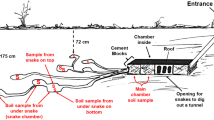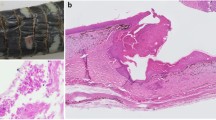Abstract
Snake fungal disease (SFD) is an emerging disease caused by the fungal pathogen, Ophidiomyces ophiodiicola. Clinical signs of SFD include dermal lesions, including regional and local edema, crusts, and ulcers. Snake fungal disease is widespread in the Eastern United States, yet there are limited data on how clinical signs of SFD compare with laboratory diagnostics. We compared two sampling methods for O. ophiodiicola, scale clip collection and swabbing, to evaluate whether collection method impacted the results of polymerase chain reaction (PCR). In addition, we evaluated the use of clinical signs to predict the presence of O. ophiodiicola across seasons, snake habitat affiliation (aquatic or terrestrial) and study sites. We found no significant difference in PCR results between sampling methods. Clinical signs were a strong predictor of O. ophiodiicola presence in spring and summer seasons. Snakes occupying terrestrial environments had a lower overall probability of testing positive for O. ophiodiicola compared to snakes occupying aquatic environments. Although our study indicates that both clinical signs of SFD and prevalence of O. ophiodiicola vary seasonally and based on habitat preferences of the host, our analysis suggests that clinical signs can serve as a reliable indicator of O. ophiodiicola presence, especially during spring and summer.




Similar content being viewed by others
References
Allender MC, Deslik M, Wylie S, Phillips C, Wylie DB, Maddox C, Delaney MA, Kinsel M (2011) Chrysosporium sp. infection in Eastern Massasauga rattlesnakes. Emerging Infectious Diseases 17:2383–2384
Allender MC, Raudabaugh DB, Gleason FH, Miller AN (2015) The natural history, ecology, and epidemiology of Ophidiomyces ophiodiicola and its potential impact on free-ranging snake populations. Fungal Ecology 17:187–196
Bates D, Maechler M, Bolker B, Walker S (2015) Fitting linear mixed-effects models using lme4. Journal of Statistical Software 67:1–48
Berger L, Speare R, Daszak P, Green DE, Cunningham AA, Goggin CL, Slocombe R, Ragan MA, Hyatt AD, McDonald KR, Hines HB, Lips KR, Marantelli G, Parkes H (1998) Chytridiomycosis causes amphibian mortality associated with population declines in the rain forests of Australia and Central America. Proceedings of the National Academy of Sciences 95:9031–9036
Blehert DS, Hicks AC, Behr M, Meteyer CU, Berlowski-zier BM, Buckles EL, Coleman JTH, Darling SR, Gargas A, Niver R, Okoniewski JC, Rudd RJ, Ward B (2008) Bat white-nose syndrome: an emerging fungal pathogen? Science 323:227
Bohuski E, Lorch JM, Griffin KM, Blehert DS (2015) TaqMan real-time polymerase chain reaction for detection of Ophidiomyces ophiodiicola, the fungus associated with snake fungal disease. BMC Veterinary Research 11:1–10
Burbrink FT, Lorch JM, Lips KR (2017) Host susceptibility to snake fungal disease is highly dispersed across phylogenetic and functional trait space. Science Advances 3:e1701387
Burnham KP, Anderson DR (2002) Model Selection and Inference—A Practical Information-Theoretic Approach, New York, NY: Springer
Clark RW, Marchand MN, Clifford BJ, Stechert R, Stephens S (2011) Decline of an isolated timber rattlesnake (Crotalus horridus) population: interactions between climate change, disease, and loss of genetic diversity. Biological Conservation 144:886–891
Fisher MC, Henk DA, Briggs CJ, Brownstein JS, Madoff LC, McCraw SL, Gurr SJ (2012) Emerging fungal threats to animal, plant and ecosystem health. Nature 484:186–194
Franklinos LH, Lorch JM, Bohuski E, Fernandez JR, Wright ON, Fitzpatrick L, Petrovan S, Durrant C, Linton C, Baláž V, Cunningham AA (2017) Emerging fungal pathogen Ophidiomyces ophiodiicola in wild European snakes. Scientific Reports 7:3844–3850
Guthrie AL, Knowles S, Ballmann AE, Lorch JM (2016) Detection of snake fungal disease due to Ophidiomyces ophiodiicola in Virginia, USA. Journal of Wildlife Diseases 52:57–69
Hileman ET, Allender MC, Bradke DR, Faust LJ, Moore JA, Ravesi MJ, Tetzlaff SJ (2018) Estimation of Ophidiomyces prevalence to evaluate snake fungal disease risk. The Journal of Wildilfe Management 82(1):173–181
Kriger KM, Hero JM (2007) Large-scale seasonal variation in the prevalence and severity of chytridiomycosis. Journal of Zoology 271:352–359
Lorch JM, Knowles S, Lankton JS, Michell K, Edwards JL, Kapfer JM, Staffen RA, Wild ER, Schmidt KZ, Ballmann AE, Blodgett D, Farrell TM, Glorioso BM, Last LA, Price SJ, Schuler KL, Smith CE, Wellehan JFX. Jr, Blehert DS (2016) Snake fungal disease: an emerging threat to wild snakes. Philosophical Transactions of the Royal Society B: Biological Sciences 371:20150457
Lorch JM, Lankton J, Werner K, Falendysz EA, McCurley K, Blehert DS (2015) Experimental infection of snakes with Ophidiomyces ophiodiicola causes pathological changes that typify snake fungal disease. mBio 6:1–9
Martel A, Spitzen-van der Sluijs A, Blooi M, Bert W, Ducatelle R, Fisher MC, Woeltjes A, Bosman W, Chiers K, Bossuyt F, Pasmans F (2013) Batrachochytrium salamandrivorans sp. nov. causes chytridiomicosis in amphibians. Proceedings of the National Academy of Sciences of the United States of America 110(38):15325–15329
Mazerolle JM (2016) AICcmodavg: Model Selection and Multimodel Inference Based on (Q)AIC(c). R Package Version 2.0-4. http://CRAN.R-project.org/package=AICcmodavg. Accessed 25 Feb 2017
McCoy, CM, Lind CM, Farrell TM (2017) Environmental and physiological correlates of the severity of clinical signs of snake fungal disease in a population of pigmy rattlesnakes, Sistrurus miliarius. Conservation Physiology 5:1–10
Nelson RJ, Demas GE (1996) Seasonal changes in immune function. The Quarterly Review of Biology 71:511–548
Oldham C, Fleckenstein JL, Boys W, Price SJ (2016) Enhancing ecological investigations of snakes with passive integrated transponder (PIT) telemetry. Herpetological Review 47:385–388
Paré JA, Sigler L, Rypien KL, Gibas CC (2003) Survey for the Chrysosporium anamorph of Nanizziopsis vriesii on the skin of healthy captive squamate reptiles and notes on theis cutaneous fungal mycobiota. Journal of Herpethological Medical Surgery 13:10–15
R Core Team (2016) R: A Language and Environment for Statistical Computing, Vienna: R Foundation for Statistical Computing
Sigler L, Hambleton S, Pare JA (2013) Molecular characterization of reptile pathogens currently known as members of the Chrysosporium anamorph of Nannizziopsis vriesii complex and relationship with some human-associated isolates. Journal of Clinical Microbiology 51:3338–3357
Stokes GD, Dunson WA (1982) Permeability and channel structure of reptilian skin. American Journal of Physiology 242(6):F681-F689
Venables WN, Ripley BD (2002) Modern Applied Statistics with S. Fourth Edition, New York: Springer
Acknowledgements
Funding for this project was provided by the Department of Forestry and Natural Resources at the University of Kentucky, the McIntire-Stennis Cooperative Forestry Research Program (#1001968), the Chicago Herpetological Society, Kentucky Academy of Sciences, the Wildlife Society-Kentucky Chapter, University of Kentucky’s Eller and Billings Student Research Award, American Society of Ichthyologists and Herpetologists’ Helen T. and Frederick M. Gaige Award, the Kentucky Society of Natural History Student Research Award, the National Geographic Society, and the US Geological Survey. We thank Mickey Agha, Phillip Arant, Jeb Ayres, Sara Beth Freytag, Jake Hutton, Michaela Lambert, Thomas Maigret, Jonathan Matthews, Mason Murphy, and Christian Oldham for assistance in the field. The use of trade, firm, or product names is for descriptive purposes only and does not imply endorsement by the US Government.
Author information
Authors and Affiliations
Corresponding author
Rights and permissions
About this article
Cite this article
McKenzie, J.M., Price, S.J., Fleckenstein, J.L. et al. Field Diagnostics and Seasonality of Ophidiomyces ophiodiicola in Wild Snake Populations. EcoHealth 16, 141–150 (2019). https://doi.org/10.1007/s10393-018-1384-8
Received:
Revised:
Accepted:
Published:
Issue Date:
DOI: https://doi.org/10.1007/s10393-018-1384-8




